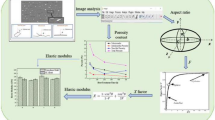Abstract
Coatings produced by air plasma spraying (APS) are characterized by a lamellar structure with high porosity, numerous microcracks and present a random microstructure. The process parameters influence not only the porosity but also the form of the microstructure defects. Different methods have been developed and used to investigate the influence of such random microstructures on the effective mechanical properties. Homogenization methods, based on asymptotic expansion of the involved fields, assume the periodicity of the microstructure. For materials with periodic microstructure they predict accurately and cost efficiently their effective properties. But, for non-periodic microstructures like APS thermal barrier coatings (TBC), the geometrical definition of the so-called representative volume element (RVE) plays a crucial role. In fact, these microstructures are approximated by periodic ones, whose characteristics (extension and phase distribution) are obtained by statistical methods. In this work, several approaches were applied to investigate the influence of the RVE position and geometry on the resulting effective properties of the TBC.










Similar content being viewed by others
References
E. Sanchez-Palencia, Non-Homogeneous Media and Vibration Theory, Springer, Berlin, 1980
A. Bensoussan, J.L. Lions, and G. Pappanicolaou, Asymptotic Analysis for Periodic Structures, North-Holland, Amsterdam 1978
Z. Hashin, S. Shtrikman, A Variational Approach to the Theory of the Elastic Behaviour of Polycrystals, J. Mech. Phys. Solid, 1962, 10, p. 335-342
R. Nickel, T. Kashko, S. Kundas, and E. Lugscheider, The Application of a Homogenized Material Model in the FEM-Simulation of the Atmospheric Plasma Spraying Coating Formation, Proceedings of Business and Industry Symposium of the 2003 Advanced Simulation Technologies Conference (ASTC 2003), Mai 5-April 04, 2003 (Orlando, USA), p 119-126
E. Lugscheider, K. Bobzin and R. Nickel, The Application of Multiscale Modeling in the Coating Formation Simulation of APS-PYSZ-TBCs, J. Therm. Spray Technol., 2006, 15, p. 537-544
T. Kashko, S. Kundas, E. Lugscheider, and R. Nickel, Homogenisation of the APS TBC Properties by Using Periodic Structures Theory, Proceedings of the 4th International Conference on Plasma Physics & Plasma Technology, Sept 15-19, 2003 (Minsk, Belarus), p 475-478
T. Kashko, S. Kundas, E. Lugscheider, and R. Nickel, The Application of the Homogenization Method to the APs Properties Investigation, Proceedings of the National Academy of Sciences of Belarus, Series of Physical-Engineering Sciences, 2004, vol 2, p 69-73 (in Russian)
E. Lugscheider, R. Nickel, S. Kundas, and T. Kashko, A Homogeneous Material Model Approach of an APS-Sprayed PYSZ-TBC Considering the APS-Process-Parameters and the TBC-Microstructure, Thermal Spray 2004: Advances in Technology and Application, May 10-12, 2004 (Osaka, Japan), ASM International, 2004, vol 1129, p 311-316
K. Bobzin, N. Bagcivan, D. Parkot and T. Kashko, Microstructure Dependency of the Material Properties: Simulation Approaches and Calculation Methods, Steel Res., 2007, 78, p. 804-811
K. Bobzin, D. Parkot, R. Nickel, and T. Kashko, The Application of Spectral Analysis in the Numerical Homogenization of Non-Periodic Structures, Proceedings of the 2007 Spring Simulation Multiconference (SpringSim’07), March 25-29, 2007 (Norfolk, USA), Volume II, Business and Industry Symposium, p 11-16
A. Fischer, “Analyse des Atmosphärischen Plasmaspritzens mittels on-line Prozesskontrolle,” Ph.D. Thesis, RWTH Aachen, Werkstoffwissenschaftliche Schriftenreihe, Bd. 53, Shaker, 2002 (in German)
G. Laschet, T. Kashko, S. Angel, J. Scheele, R. Nickel, W. Bleck and K. Bobzin, Microstructure Based Model for Permeability Predictions of Open-Cell Metallic Foams via Homogenization, Mater. Sci. Eng., 2008, vol. 472, p. 214-226
K. Bobzin, E. Lugscheider, R. Nickel and T. Kashko, Advanced Homogenization Strategies in Materials Modeling of Thermally Sprayed TBCs, Adv Eng Mater, 2006, 8, p. 663-669
T. Kanit, S. Forest, I. Galliet, V. Mounoury, and D. Jeulin, Determination of the Size of the Representative Volume Element for Random Composites: Statistical and Numerical Approach, Int. J. Solid Struct., 2003 (40), p 3647-3679
Acknowledgments
The authors would like to thank the German Research Foundation DFG for the support of the depicted research within the Cluster of Excellence “Integrative Production Technology for High-Wage Countries”.
Author information
Authors and Affiliations
Corresponding author
Rights and permissions
About this article
Cite this article
Bobzin, K., Bagcivan, N., Parkot, D. et al. Influence of the Definition of the Representative Volume Element on Effective Thermoelastic Properties of Thermal Barrier Coatings with Random Microstructure. J Therm Spray Tech 18, 988–995 (2009). https://doi.org/10.1007/s11666-009-9351-0
Received:
Revised:
Published:
Issue Date:
DOI: https://doi.org/10.1007/s11666-009-9351-0




